Morphological Characteristics and Phylogeny Reveal Six New Species in Russula Subgenus Russula (Russulaceae, Russulales) from Yanshan Mountains, North China
Abstract
1. Introduction
2. Materials and Methods
2.1. Sampling and Morphological Observations
2.2. DNA Extraction and Sequencing
2.3. Molecular Phylogenetic Analyses

3. Results
3.1. Phylogenetic Analyses
3.2. Taxonomy
4. Discussion
Author Contributions
Funding
Institutional Review Board Statement
Informed Consent Statement
Data Availability Statement
Acknowledgments
Conflicts of Interest
References
- Buyck, B.; Zoller, S.; Hofstetter, V. Walking the thin line ten years later: The dilemma of above-versus below-ground features to support phylogenies in the Russulaceae (Basidiomycota). Fungal Divers. 2018, 89, 267–292. [Google Scholar] [CrossRef]
- Adamčík, S.; Looney, B.; Caboň, M.; Jančovičová, S.; Adamčíková, K.; Avis, P.G.; Barajas, M.; Bhatt, R.P.; Corrales, A.; Das, K.; et al. The quest for a globally comprehensible Russula language. Fungal Divers. 2019, 99, 369–449. [Google Scholar] [CrossRef]
- Romagnesi, H. Les Russules d’Europe et d’Afrique du Nord; Bordas: Paris, France, 1967. [Google Scholar]
- Singer, R. The Agaricales in Modern Taxonomy, 4th ed.; Bishen Singh Mahendra Pal Singh: Dehradun, India, 1986; Plates 1–88; pp. 1–981. [Google Scholar]
- Sarnari, M. Monografia Illustrate del Genere Russula in Europa; Tromo Primo, AMB, Centro Studi Micologici: Trento, Italy, 1998. [Google Scholar]
- Chen, B.; Song, J.; Zhang, J.H.; Liang, J.F. Morphology and molecular phylogeny reveal two new species in Russula sect. Ingratae from China. Phytotaxa 2021, 525, 109–123. [Google Scholar] [CrossRef]
- Looney, B.P.; Meidl, P.; Piatek, M.J.; Miettinen, O.; Martin, F.M.; Matheny, P.B.; Labbé, J.L. Russulaceae: A new genomic dataset to study ecosystem function and evolutionary diversification of ectomycorrhizal fungi with their tree associates. New Phytol. 2018, 218, 54–65. [Google Scholar] [CrossRef] [PubMed]
- Song, J.; Li, H.J.; Wu, S.J.; Chen, Q.Q.; Yang, G.; Zhang, J.Y.; Liang, J.F.; Chen, B. Morphological and Molecular Evidence for Two New Species within Russula Subgenus Brevipes from China. Diversity 2022, 14, 112. [Google Scholar] [CrossRef]
- Wang, X.H.; Yang, Z.L.; Li, Y.C.; Knudsen, H.; Liu, P.G. Russula griseocarnosa sp. nov. (Russulaceae, Russulales), a commercially important edible mushroom in tropical China: Mycorrhiza, phylogenetic position, and taxonomy. Nova Hedwig. 2009, 88, 269–282. [Google Scholar] [CrossRef]
- Park, M.S.; Lee, H.; Oh, S.Y.; Jung, P.E.; Seok, S.J.; Fong, J.J.; Lim, Y.W. Species delimitation of three species within the Russula subgenus Compacta in Korea: R. eccentrica, R. nigricans and R. subnigricans. J. Microbiol. 2014, 52, 631–638. [Google Scholar] [CrossRef]
- Wang, X.H. Taxonomic comments on edible species of Russulaceae. Mycosystema 2020, 39, 1617–1639. [Google Scholar] [CrossRef]
- Wu, F.; Zhou, L.W.; Yang, Z.L.; Bau, T.; Li, T.H.; Dai, Y.C. Resource diversity of Chinese macrofungi: Edible, medicinal and poisonous species. Fungal Divers. 2019, 98, 1–76. [Google Scholar] [CrossRef]
- Miller, S.L.; Buyck, B. Molecular phylogeny of the genus Russula in Europe with a comparison of modern infrageneric classifications. Mycol. Res. 2002, 106, 259–276. [Google Scholar] [CrossRef]
- Buyck, B.; Wang, X.H.; Adamíková, K.; Caboň, M.; Adamčík, S. One step closer to unravelling the origin of Russula: Subgenus Glutinosae subg. nov. Mycosphere 2020, 11, 285–304. [Google Scholar] [CrossRef]
- Patouillard, N. Quelques champignons du Tibet. J. Bot. 1893, 7, 343–344. [Google Scholar]
- Chen, B.; Song, J.; Liang, J.; Li, Y.K. Two new species of Russula subsect. Virescentinae from southern China. Mycol. Prog. 2021, 20, 993–1005. [Google Scholar] [CrossRef]
- Chen, B.; Song, J.; Chen, Y.; Zhang, J.; Liang, J. Morphological and phylogenetic evidence for two new species of Russula subg. Heterophyllidia from Guangdong Province of China. MycoKeys 2021, 82, 139–157. [Google Scholar] [CrossRef]
- Chen, B.; Liang, J.; Jiang, X.; Song, J. Morphological Characters and Molecular Phylogeny Reveal Three New Species of Subgenus Russula from China. Life 2022, 12, 480. [Google Scholar] [CrossRef]
- Wijayawardene, N.N.; Hyde, K.D.; Al-Ani, L.K.T.; Tedersoo, L.; Haelewaters, D.; Rajeshkumar, K.C.; Zhao, R.L.; Aptroot, A.; Leontyev, D.V.; Saxena, R.K.; et al. Outline of Fungi and fungus-like taxa. Mycosphere 2020, 11, 1060–1456. [Google Scholar] [CrossRef]
- Shimono, Y.; Kato, M.; Takamatsu, S. Molecular phylogeny of Russulaceae (Basidiomycetes; Russulales) inferred from the nucleotide sequences of nuclear large subunit rDNA. Mycoscience 2004, 45, 306–316. [Google Scholar] [CrossRef]
- Song, J.; Chen, B.; Liang, J.F.; Li, H.J.; Lu, J.K. Morphology and phylogeny reveal Russula subpunctipes sp. nov. from southern China. Phytotaxa 2022, 459, 16–24. [Google Scholar] [CrossRef]
- Song, J.; Liang, J.F.; Mehrabi-Koushki, M.; Krisai-Greilhuber, I.; Haelewaters, D. Fungal systematics and evolution 5. Sydowia 2019, 71, 141–245. [Google Scholar] [CrossRef]
- Li, G.J.; Zhao, Q.; Zhao, D.; Yue, S.F.; Li, S.F.; Wen, H.A.; Liu, X.Z. Russula atroaeruginea and Russula sichuanensis spp. nov. from southwest China. Mycotaxon 2013, 124, 173–188. [Google Scholar] [CrossRef]
- Li, G.J.; Zhang, C.L.; Zhao, L.; Lin, F.C. Two new species of Russula from Northeast China. Mycosphere 2018, 9, 431–443. [Google Scholar] [CrossRef]
- Li, G.J.; Deng, C.; Shi, L.; Meng, Q.; Li, S. Three new species of Russula subsect. Lactarioideae from China. Mycosystema 2020, 39, 618–636. [Google Scholar] [CrossRef]
- Li, G.J.; Li, S.M.; Buyck, B.; Zhao, S.Y.; Xie, X.J.; Shi, L.Y.; Deng, C.Y.; Meng, Q.F.; Sun, Q.B.; Yan, J.Q.; et al. Three new Russula species in sect. Ingratae (Russulales, Basidiomycota) from southern China. MycoKeys 2021, 84, 103–139. [Google Scholar] [CrossRef] [PubMed]
- Li, F.; Li, G.J.; Zhang, J.; Gao, H.; Shi, S.; Deng, C.Y. Russula fanjing, a new species of Russula subsect. Russula (Russulaceae, Russulales) from Guizhou province, China. Phytotaxa 2021, 480, 139–151. [Google Scholar] [CrossRef]
- Cao, Y.; Zhang, Y.; Yu, Z.F.; Mi, F.; Liu, C.L.; Tang, X.Z.; Long, Y.X.; He, X.X.; Wang, P.F.; Xu, J.P. Structure, gene flow, and recombination among geographic populations of a Russula virescens ally from southwestern China. PLoS ONE 2013, 8, e73174. [Google Scholar] [CrossRef]
- Hyde, K.D.; Tennakoon, D.S.; Jeewon, R.; Bhat, D.J.; Maharachchikumbura, S.S.N.; Rossi, W.; Leonardi, M.; Lee, H.B.; Mun, H.Y.; Houbraken, J.; et al. Fungal diversity notes 1036–1150: Taxonomic and phylogenetic contributions on genera and species of fungal taxa. Fungal Divers. 2019, 96, 1–242. [Google Scholar] [CrossRef]
- Wang, X.; Das, K.; Bera, I.; Chen, Y.; Buyck, B. Fungal biodiversity profiles 81-90. Cryptogam. Mycol. 2019, 40, 57–95. [Google Scholar] [CrossRef]
- Zhou, S.; Song, Y.; Chen, K.; Li, J.; Qiu, L. Three novel species of Russula pers. subg. Compactae (fr.) bon from Dinghushan Biosphere Reserve in Southern China. Cryptogam. Mycol. 2020, 41, 13–16. [Google Scholar] [CrossRef]
- Li, G.J.; Li, S.F.; Zhao, D.; Wen, H.A. Recent research progress of Russula (Russulales, Agaricomycetes): A review. Mycosystema 2015, 34, 821–848. [Google Scholar] [CrossRef]
- Li, G.J.; Li, S.F.; Wen, H.A. Ruaaula zhejiangensis sp. nov. from East China. Cryptogam. Mycol. 2011, 32, 127–133. [Google Scholar] [CrossRef]
- Li, F.; Deng, Q.L. Three new species of Russula from South China. Mycol. Prog. 2018, 17, 1305–1321. [Google Scholar] [CrossRef]
- Song, Y.; Xie, X.C.; Buyck, B. Two novel species of subgenus Russula crown clade (Russulales, Basidiomycota) from China. Eur. J. Taxon. 2021, 775, 15–33. [Google Scholar] [CrossRef]
- Ghosh, A.; Das, K.; Buyck, B. Two new species in the Russula (Russulaceae, Basidiomycota) crown clade from Indian Himalaya. Eur. J. Taxon. 2021, 782, 157–172. [Google Scholar] [CrossRef]
- Wang, Y.T.; Huang, Z.H.; Wang, J.; Zhang, T.; Cui, G.F. The population structure and dynamic characteristics of Phellodendron amurense in Yanshan Mountains. Acta Ecol. Sin. 2021, 47, 2826–2834. [Google Scholar] [CrossRef]
- Zhou, H.; Cheng, G.Q.; Sun, X.M.; Cheng, R.Y.; Zhang, H.L.; Dong, Y.M.; Hou, C.L. Three new species of Candolleomyces (Agaricomycetes, Agaricales, Psathyrellaceae) from the Yanshan Mountains in China. MycoKeys 2022, 88, 109–121. [Google Scholar] [CrossRef]
- Zhou, H.; Cheng, G.Q.; Hou, C.L. A new species, Russula luteolamellata (Russulaceae, Russulales) from China. Phytotaxa 2022, 556, 136–148. [Google Scholar] [CrossRef]
- Caboň, M.; Eberhardt, U.; Looney, B.; Hampe, F.; Kolařík, M.; Jančovičová, S.; Verbeken, A.; Adamčík, S. New insights in Russula subsect. Rubrinae: Phylogeny and the quest for synapomorphic characters. Mycol. Prog. 2017, 16, 877–892. [Google Scholar] [CrossRef]
- White, T.J.; Bruns, T.; Lee, S.; Taylor, J. Amplifcation and direct sequencing of fungal ribosomal RNA genes for phylogenetics. PCR Protoc. A Guide Methods Appl. 1990, 18, 315–322. [Google Scholar] [CrossRef]
- Vilgalys, R.; Hester, M. Rapid genetic identification and mapping of enzymatically amplified ribosomal DNA from several Cryptococcus species. J. Bacteriol. 1990, 172, 4238–4246. [Google Scholar] [CrossRef]
- Matheny, P.B. Improving phylogenetic inference of mushrooms with rpb1 and rpb2 nucleotide sequences (Inocybe; Agaricales). Mol. Phylogenetics Evol. 2005, 35, 1–20. [Google Scholar] [CrossRef]
- Morehouse, E.A.; James, T.Y.; Ganley, A.R.D.; Vilgalys, R.; Berger, L.; Murphy, P.J.; Longcore, J.E. Multilocus sequences typing suggests the chytrid pathogen of amphibians is a recently emerged clone. Mol. Ecol. 2003, 12, 395–403. [Google Scholar] [CrossRef] [PubMed]
- Tamura, K.; Stecher, G.; Peterson, D.; Filipski, A.; Kumar, S. MEGA6: Molecular evolutionary genetics analysis version 6.0. Mol. Biol. Evol. 2013, 30, 2725–2729. [Google Scholar] [CrossRef] [PubMed]
- Stamatakis, A. RAxML-VI-HPC: Maximum likelihood-based phylogenetic analysis with thousands of taxa and mixed models. Bioinformatics 2006, 22, 2688–2690. [Google Scholar] [CrossRef] [PubMed]
- Stamatakis, A.; Hoover, P.; Rougemont, J. A rapid bootstrap algorithm for the RAxML web servers. Syst. Biol. 2008, 57, 758–771. [Google Scholar] [CrossRef] [PubMed]
- Zhou, H.; Hou, C.L. Three new species of Diaporthe from China based on morphological characters and DNA sequence data analysis. Phytotaxa 2019, 422, 157–174. [Google Scholar] [CrossRef]
- Zhou, H.; Wang, Q.T.; Tong, X.; Hou, C.L. Phylogenetic analysis of Engleromyces sinensis and identification of cytochalasin D from culture. Mycol. Prog. 2021, 20, 1343–1352. [Google Scholar] [CrossRef]
- Guindon, S.; Dufayard, J.F.; Lefort, V.; Anisimova, M.; Hordijk, W.; Gascuel, O. New algorithms and methods to estimate maximum-likelihood phylogenies: Assessing the performance of PhyML 3.0. Syst. Biol. 2010, 59, 307–321. [Google Scholar] [CrossRef]
- Ronquist, F.; Huelsenbeck, J.P. MrBayes 3: Bayesian phylogenetic inference under mixed models. Bioinformatics 2003, 19, 1572–1574. [Google Scholar] [CrossRef]
- Hillis, D.M.; Bull, J.J. An empirical test of bootstrapping as a method for assessing confidence in phylogenetic analysis. Syst. Biol. 1993, 42, 182–192. [Google Scholar] [CrossRef]
- Rannala, B.; Yang, Z. Probability distribution of molecular evolutionary trees: A new method of phylogenetic inference. J. Mol. Evol. 1996, 43, 304–311. [Google Scholar] [CrossRef]
- Posada, D.; Crandall, K.A. Modeltest: Testing the model of DNA substitution. Bioinformatics 1998, 14, 817–818. [Google Scholar] [CrossRef] [PubMed]
- Romagnesi, H. Novitates 3: Status et Noms nouveaux pour les taxa infragénériques dans le Genre Russula. Doc. Mycol. 1987, 69, 39–40. [Google Scholar]
- Phookamsak, R.; Hyde, K.D.; Jeewon, R.; Bhat, D.J.; Jones, E.B.; Maharachchikumbura, S.S.; Raspé, O.; Karunarathna, S.C.; Wanasinghe, D.N.; Hongsanan, S.; et al. Fungal diversity notes 929–1035: Taxonomic and phylogenetic contributions on genera and species of fungi. Fungal Divers. 2019, 95, 1–273. [Google Scholar] [CrossRef]
- Phillips, R. Mushrooms: A Comprehensive Guide to Mushroom Identification; Pan Macmillan: London, UK, 2006; pp. 1–376. [Google Scholar]
- Romagnesi, H. Une Russule nouvelle: Russula odorata Romagn. Bull. Mens. De La Société Linnéenne De Lyon 1950, 19, 75–77. [Google Scholar] [CrossRef]
- Chou, W.N.; Wang, Y.Z. Nine species or Russula (Basidiomycotina) New to Taiwan. Taiwania 2005, 50, 93–100. [Google Scholar] [CrossRef]
- Gerault, A.; Florule evolutive des Basidiomycotina du Finistere. Homobasidiomycetes. Agaricales. 2005. Version 2.1. pp. 1–183. Available online: http://projet.aulnaies.free.fr/Florules/AGARICALES.pdf (accessed on 10 November 2022).
- Hessler, L.R. A Study of Russula Types; Torrey Botanical Society: Durham, Germany, 1960; pp. 1–59. [Google Scholar]
- Das, K.; Ghosh, A.; Buyck, B.; Hembrom, M.E. Two new species of Russula subgenus Compactae from Indian Himalaya based on morphology and molecular phylogenetic inferences. Nord. J. Bot. 2020, 38, e02962. [Google Scholar] [CrossRef]
- Ariyawansa, H.A.; Hyde, K.D.; Jayasiri, S.C.; Buyck, B.; Chethana, K.W.T.; Dai, D.Q.; Dai, Y.C.; Daranagama, D.A.; Jayawardena, R.S.; Lücking, R.; et al. Fungal diversity notes 111–252: Taxonomic and phylogenetic contributions to fungal taxa. Fungal Divers. 2015, 75, 27–274. [Google Scholar] [CrossRef]
- Li, G.J.; Hyde, K.D.; Zhao, R.L.; Hongsanan, S.; Abdel-Aziz, F.A.; Abdel-Wahab, M.A.; Alvarado, P.; Alves-Silva, G.; Ammirati, J.F.; Ariyawansa, H.A.; et al. Fungal diversity notes 253–366: Taxonomic and phylogenetic contributions to fungal taxa. Fungal Divers. 2016, 78, 1–237. [Google Scholar] [CrossRef]
- Li, G.J.; Li, S.F.; Liu, X.Z.; Wen, H.A. Russula jilinensis sp. nov. (Russulaceae) from northeast china. Mycotaxon 2012, 120, 49–58. [Google Scholar] [CrossRef]
- Jiang, X.M.; Li, Y.K.; Liang, J.F.; Wu, J.R. Russula brunneovinacea sp. nov., from northeastern China. Mycotaxon 2017, 132, 789–797. [Google Scholar] [CrossRef]
- Singer, R. Monographie der Gattung Russula. Beih. Zum Bot. Centralblatt. 1932, 49, 205–380. [Google Scholar]
- Roberts, C. Russulas of Southern Vancouver Island Coastal Forests. Doctoral dissertation, University of Victoria, Victoria, BC, Canada, 2007.
- Boa, E. Wild Edible Fungi a Global Overview of Their Use and Importance to People; Food and Agriculture Organization of the United Nations: Rome, Italy, 2004; pp. 1–147. [Google Scholar]
- Li, G.J. The Taxonomy of Russula in China; Chinese Academy of Sciences: Beijing, China, 2014; pp. 1–630. [Google Scholar]
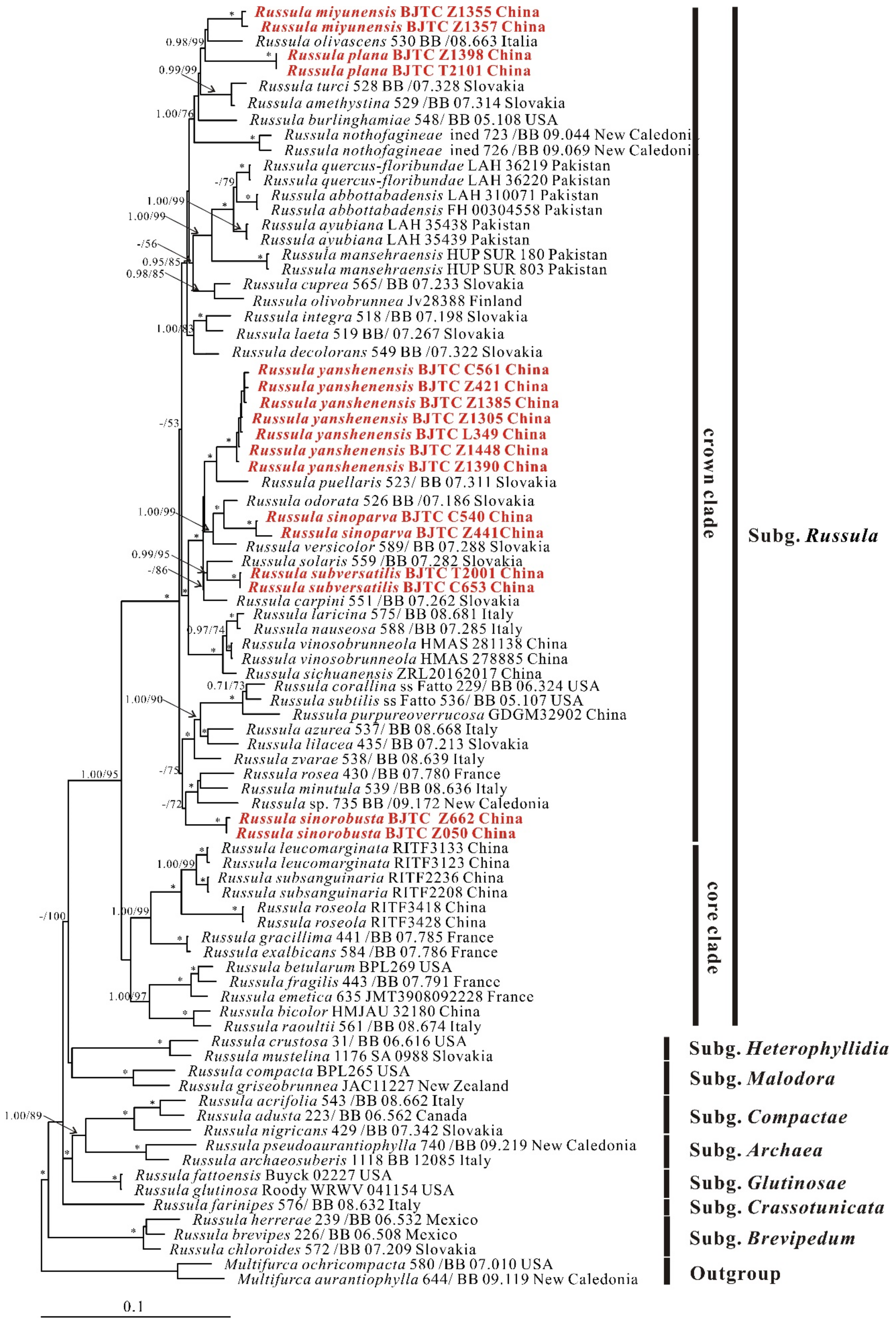
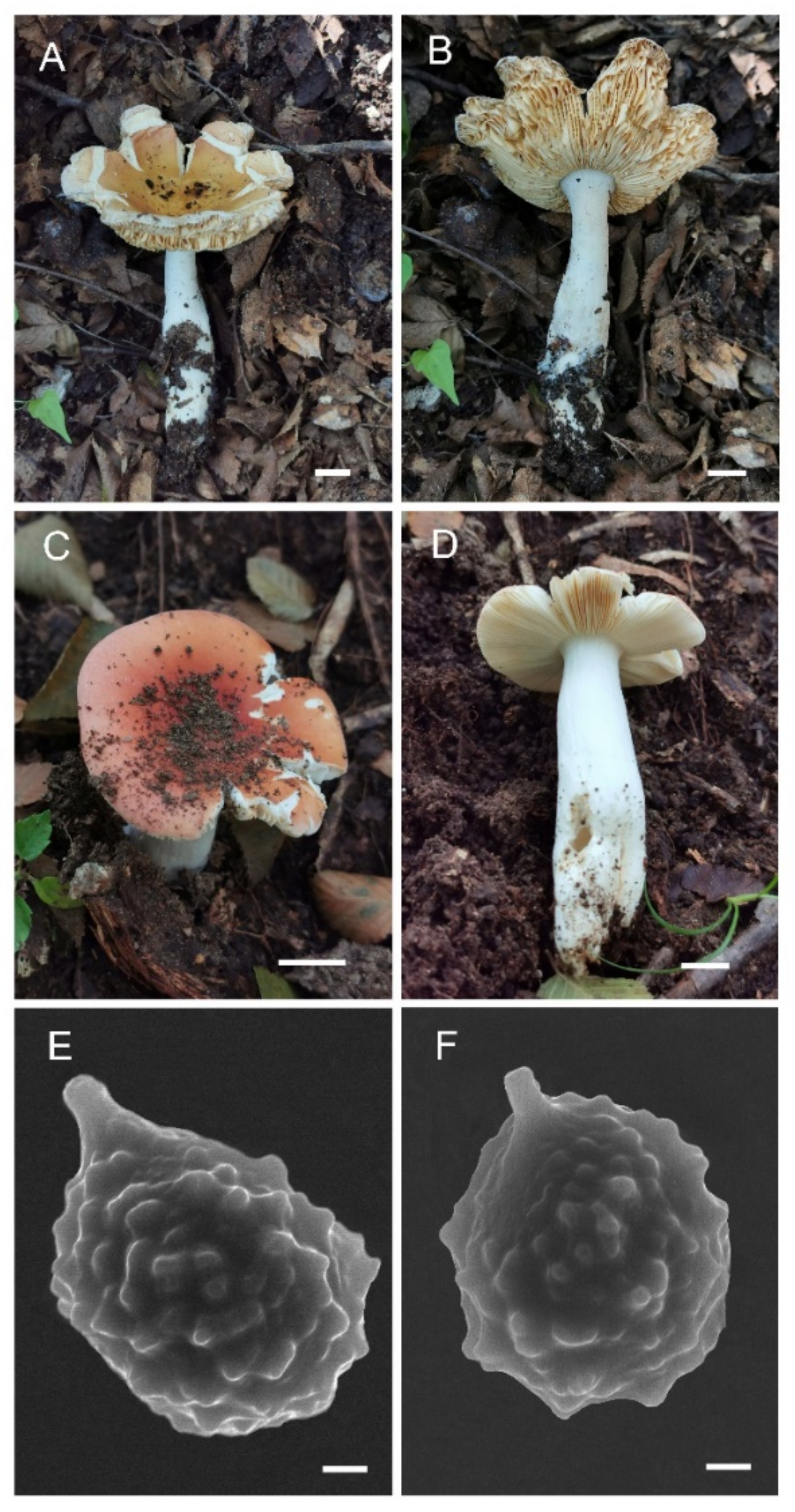
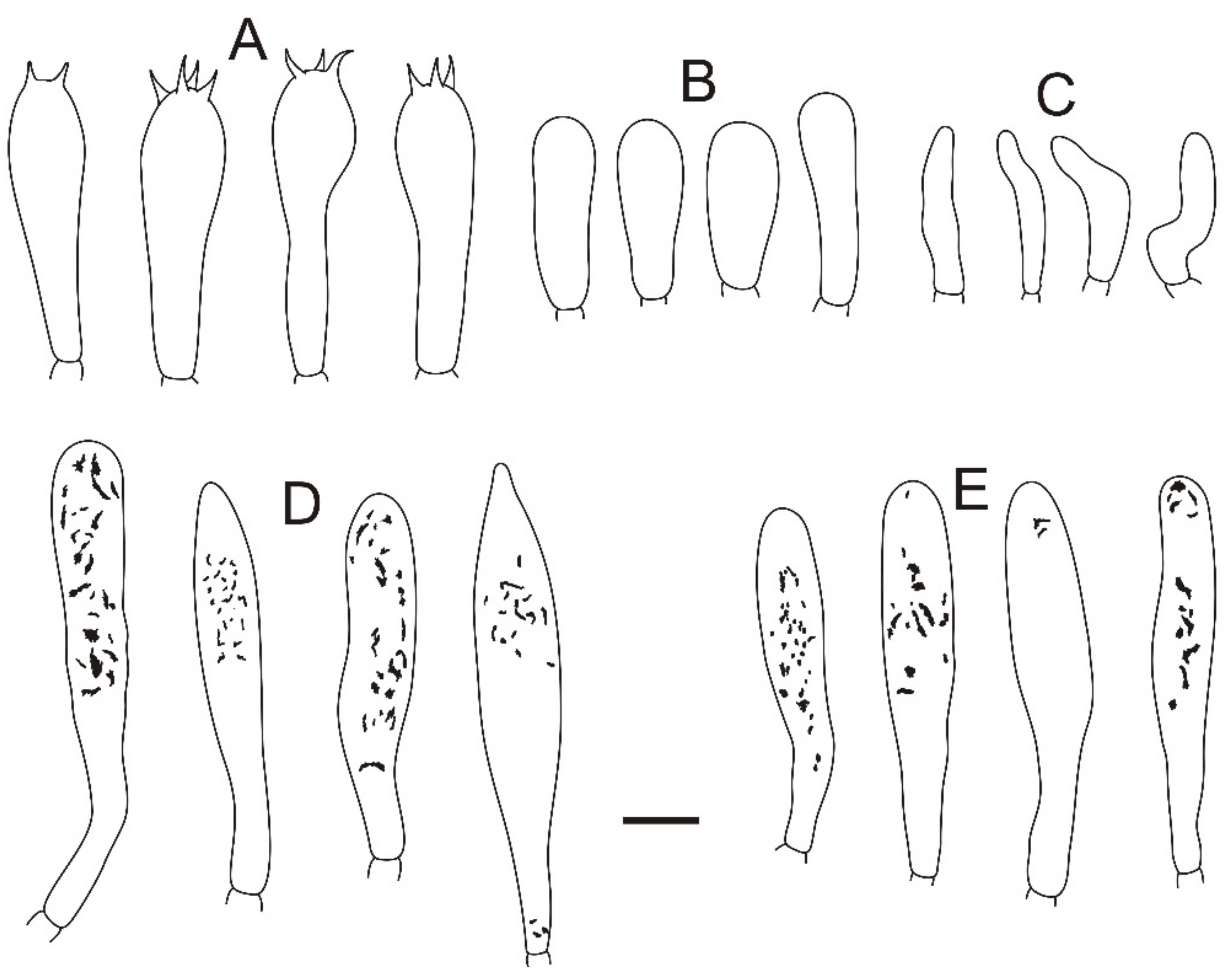

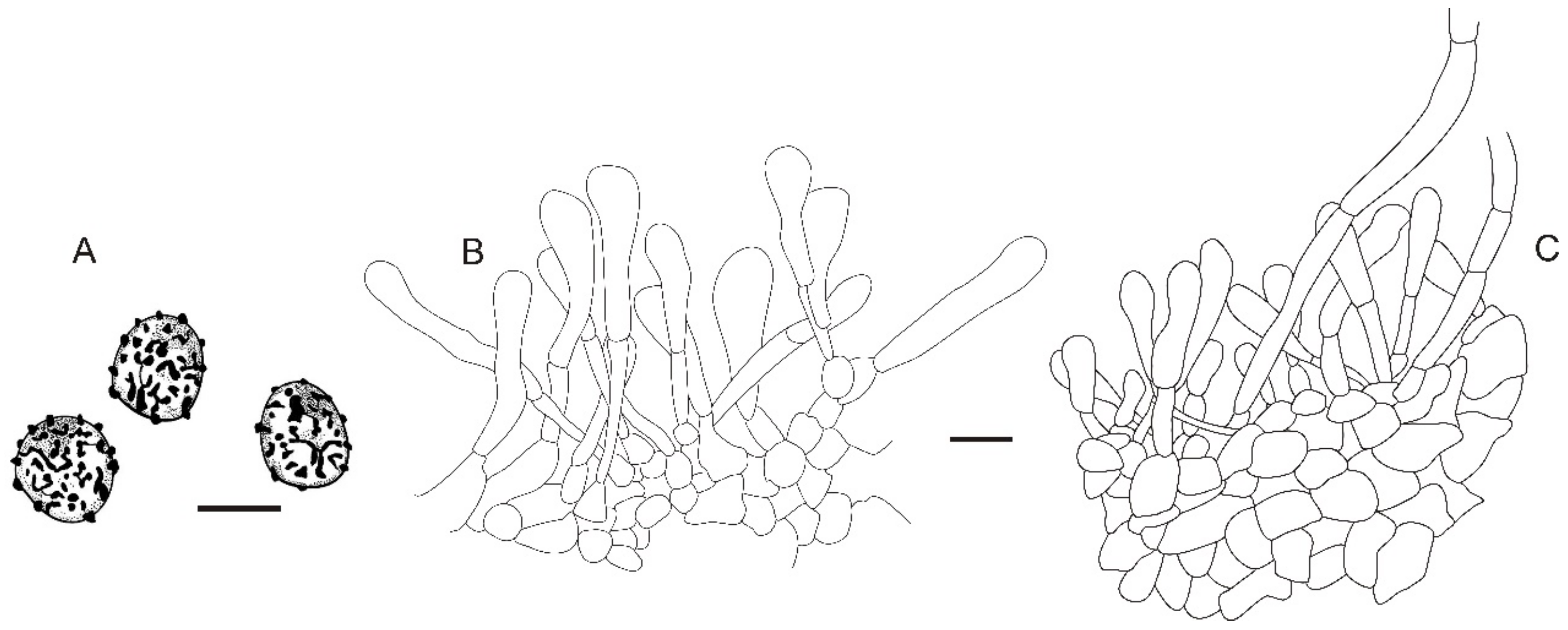

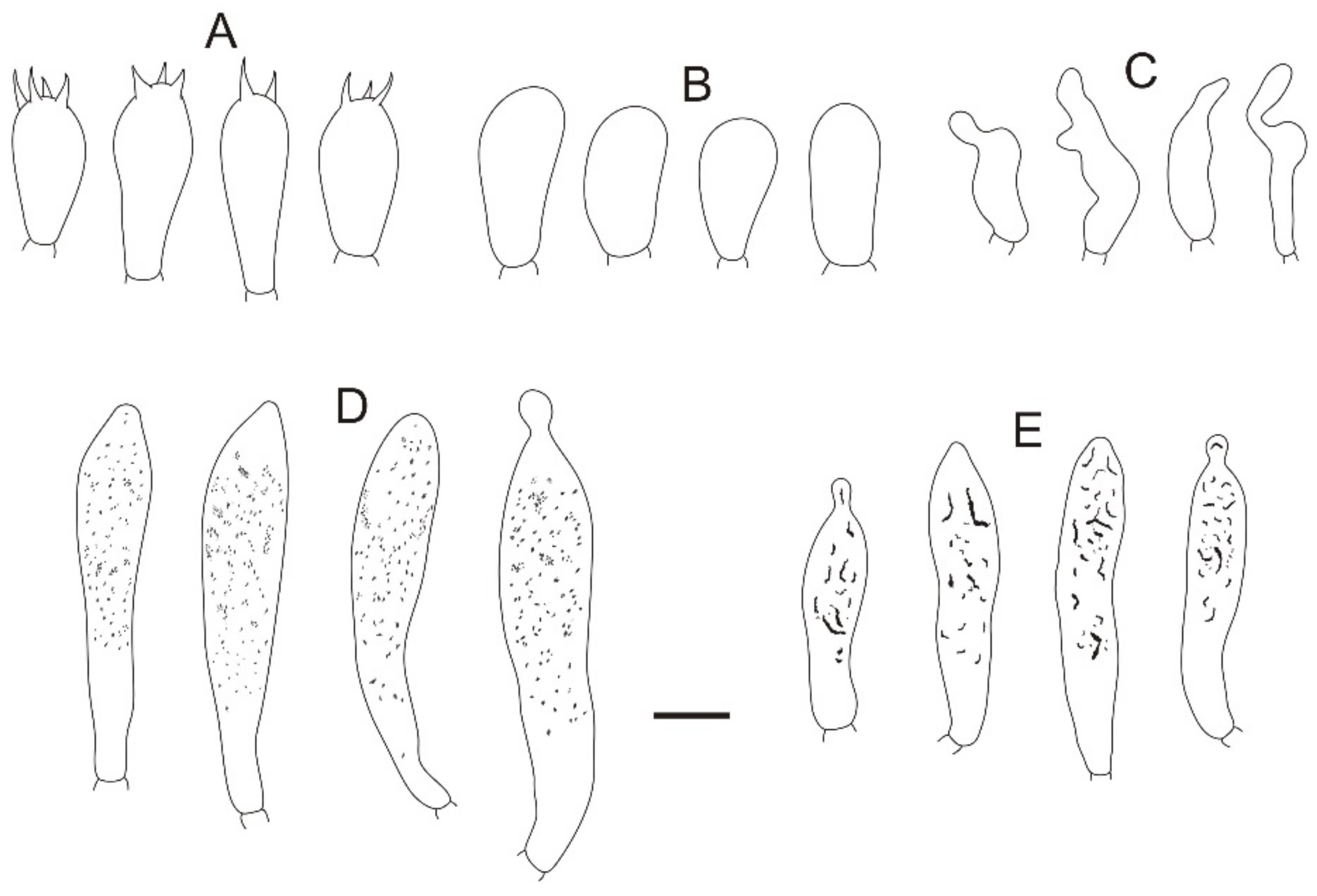
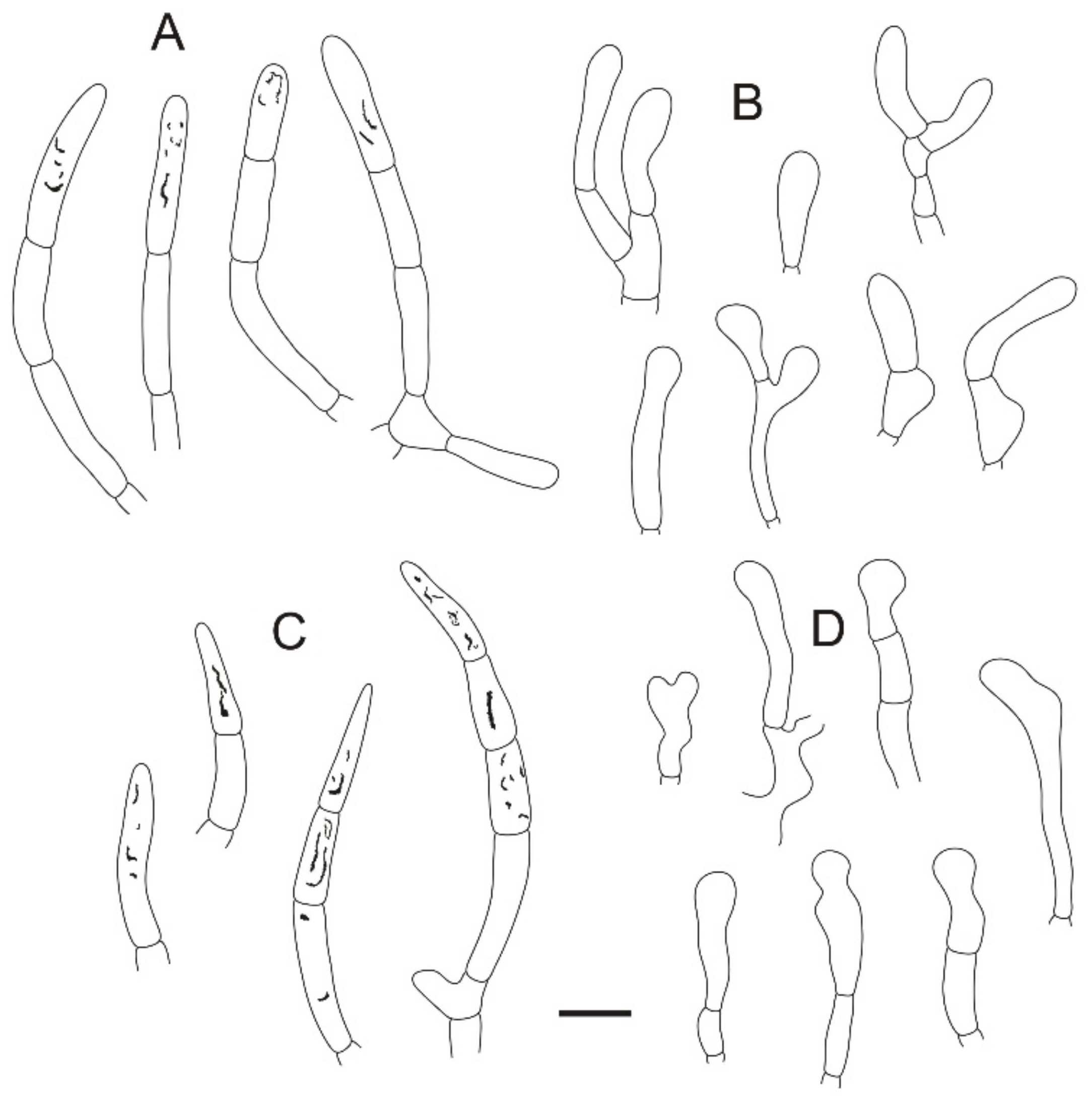

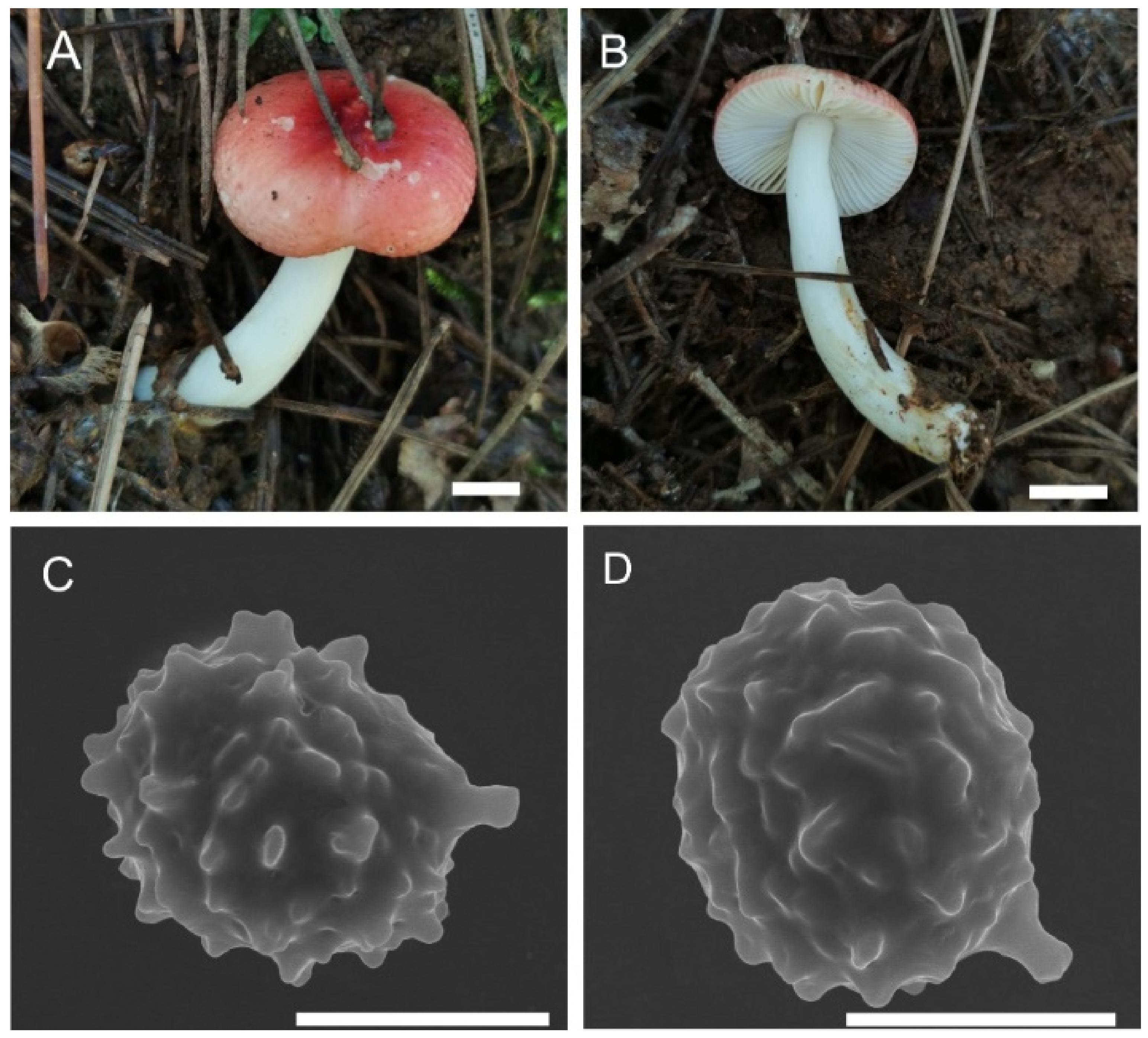
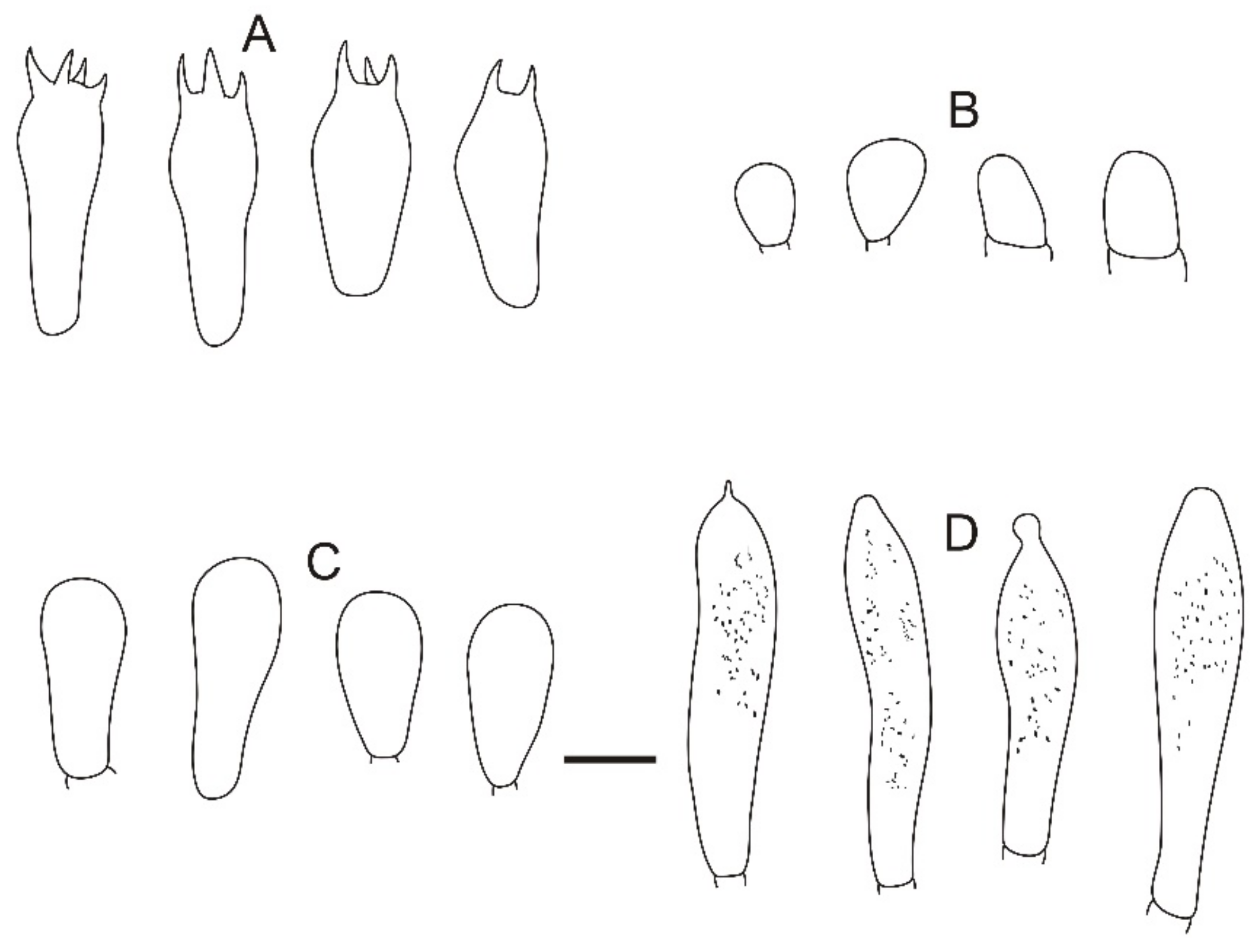
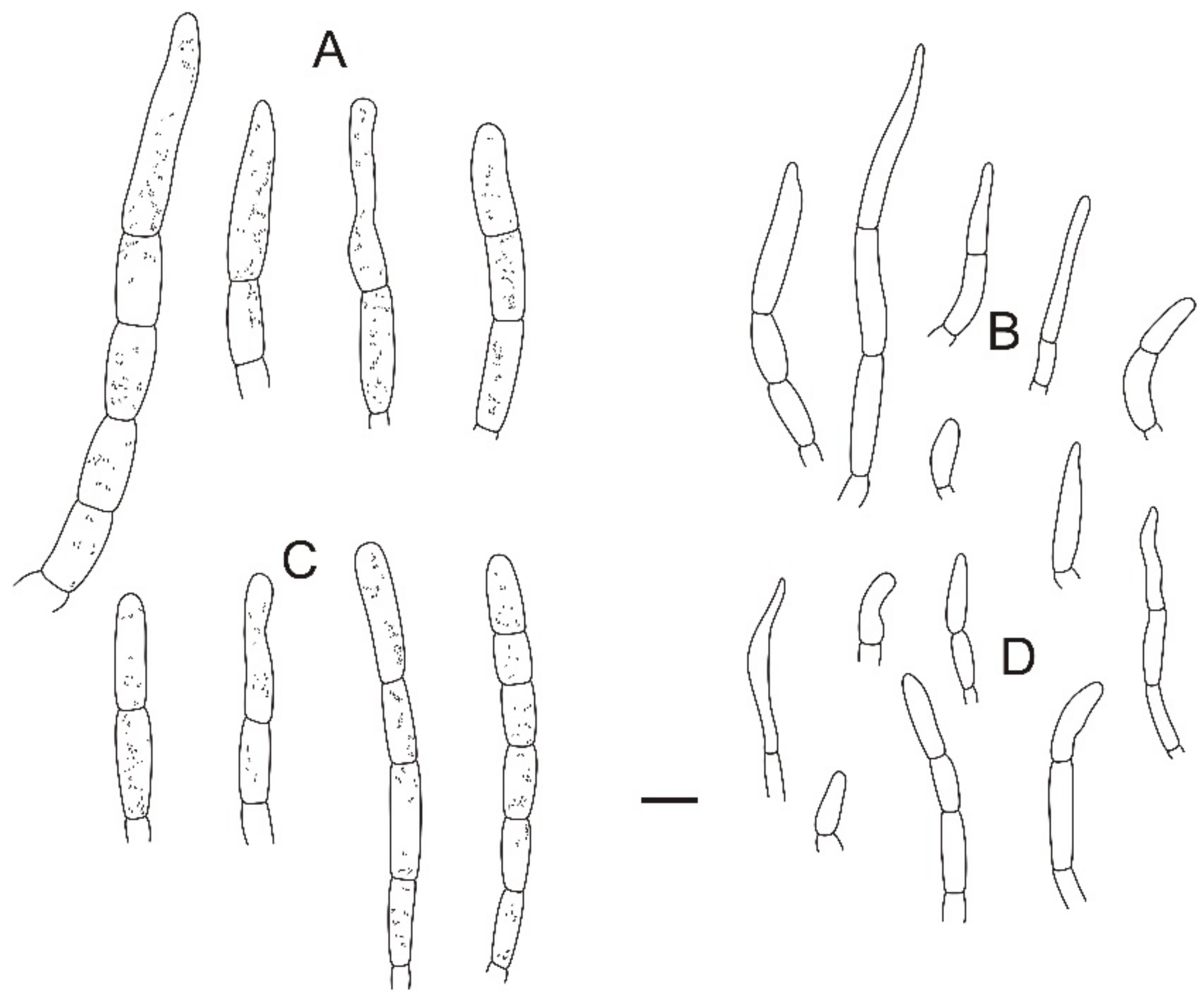
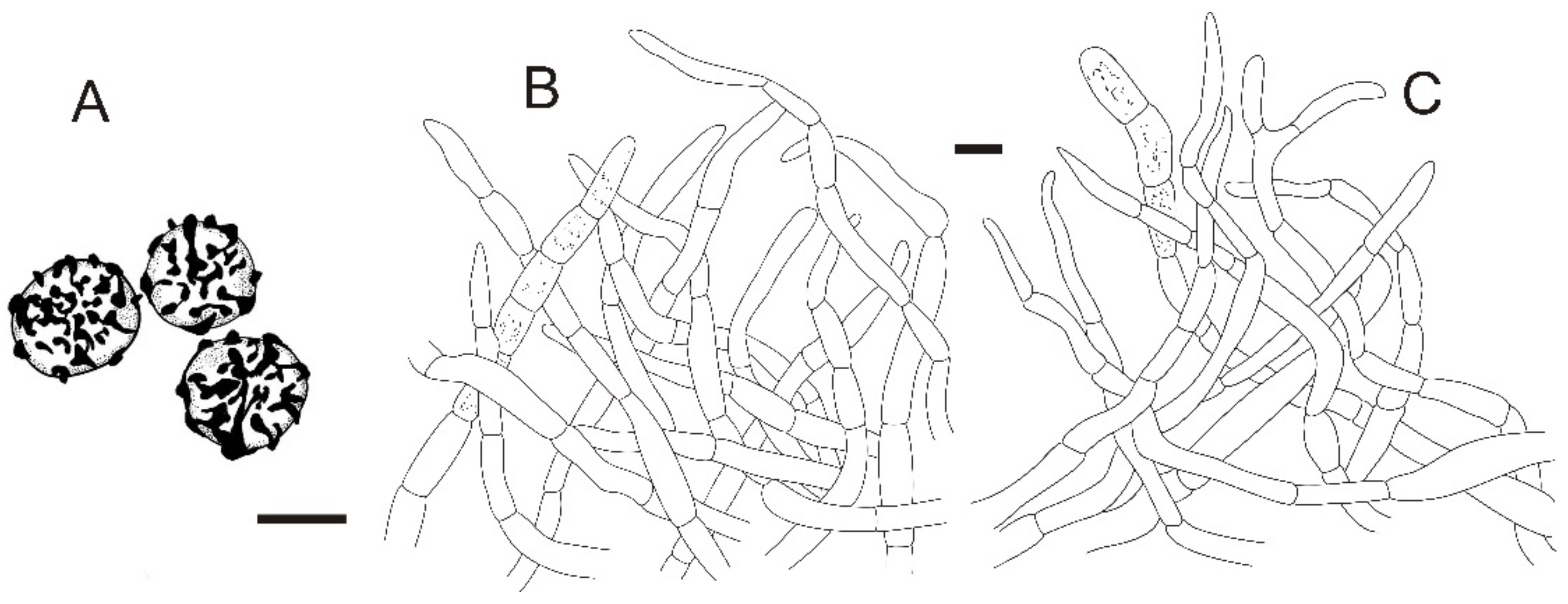
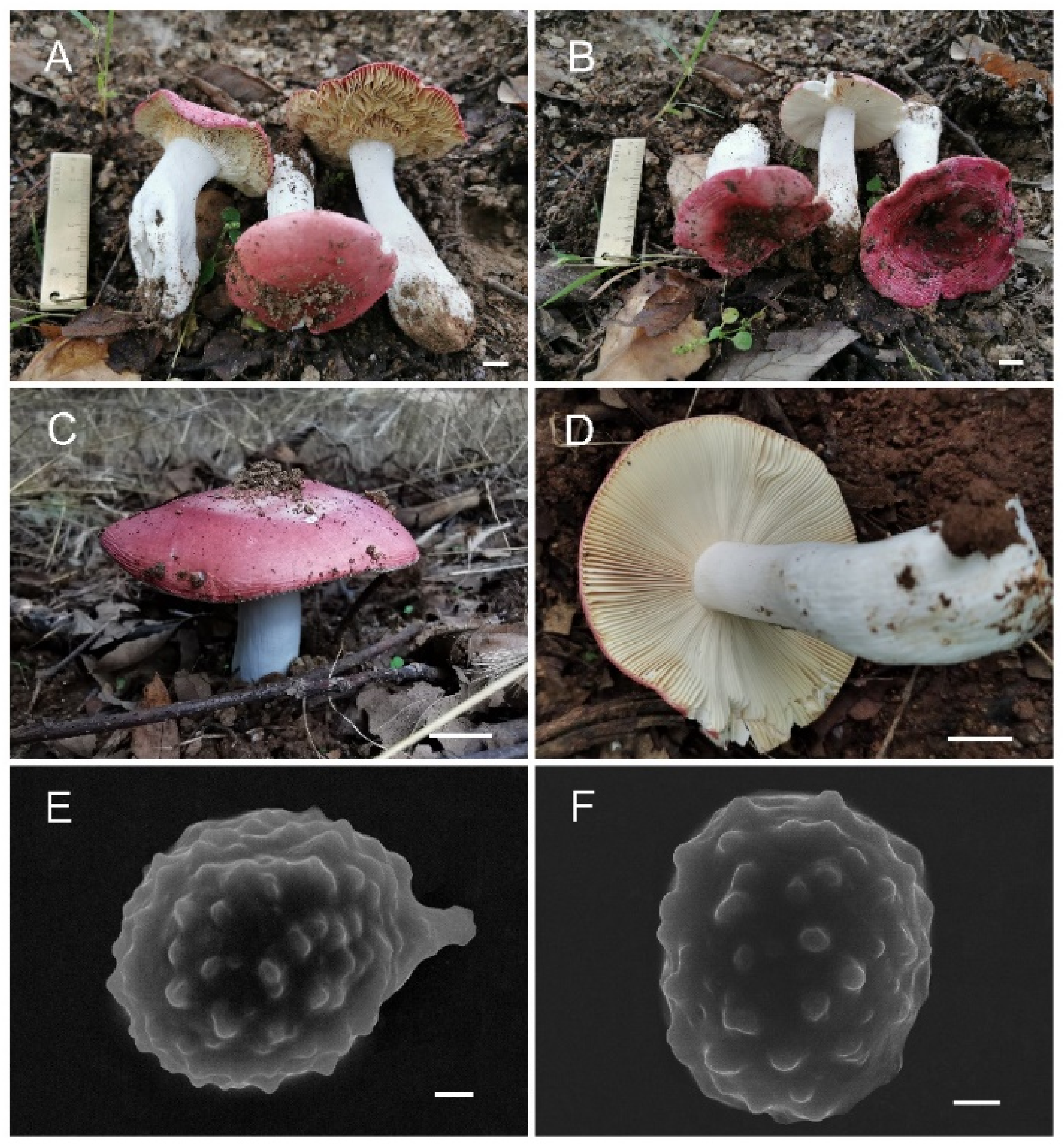

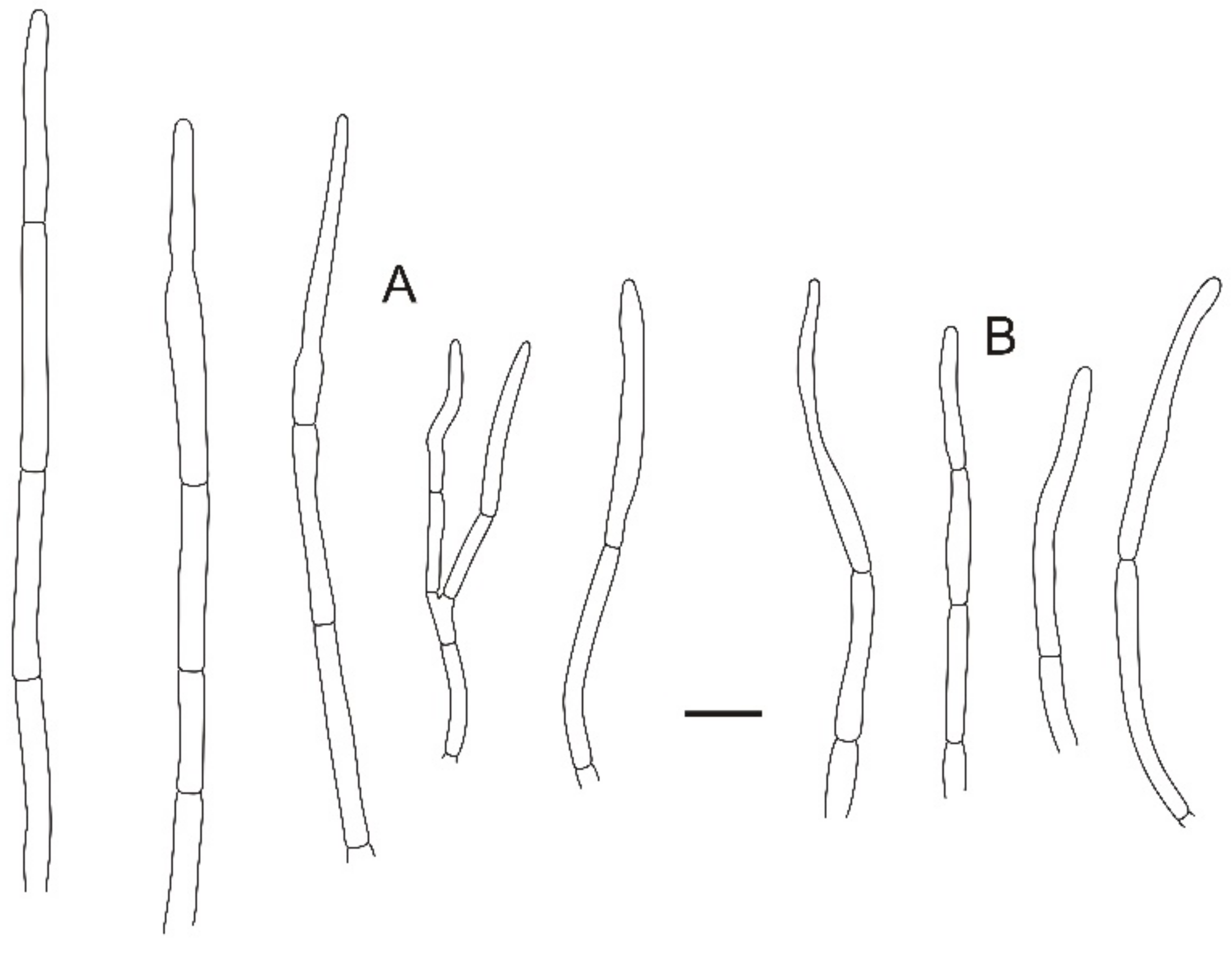
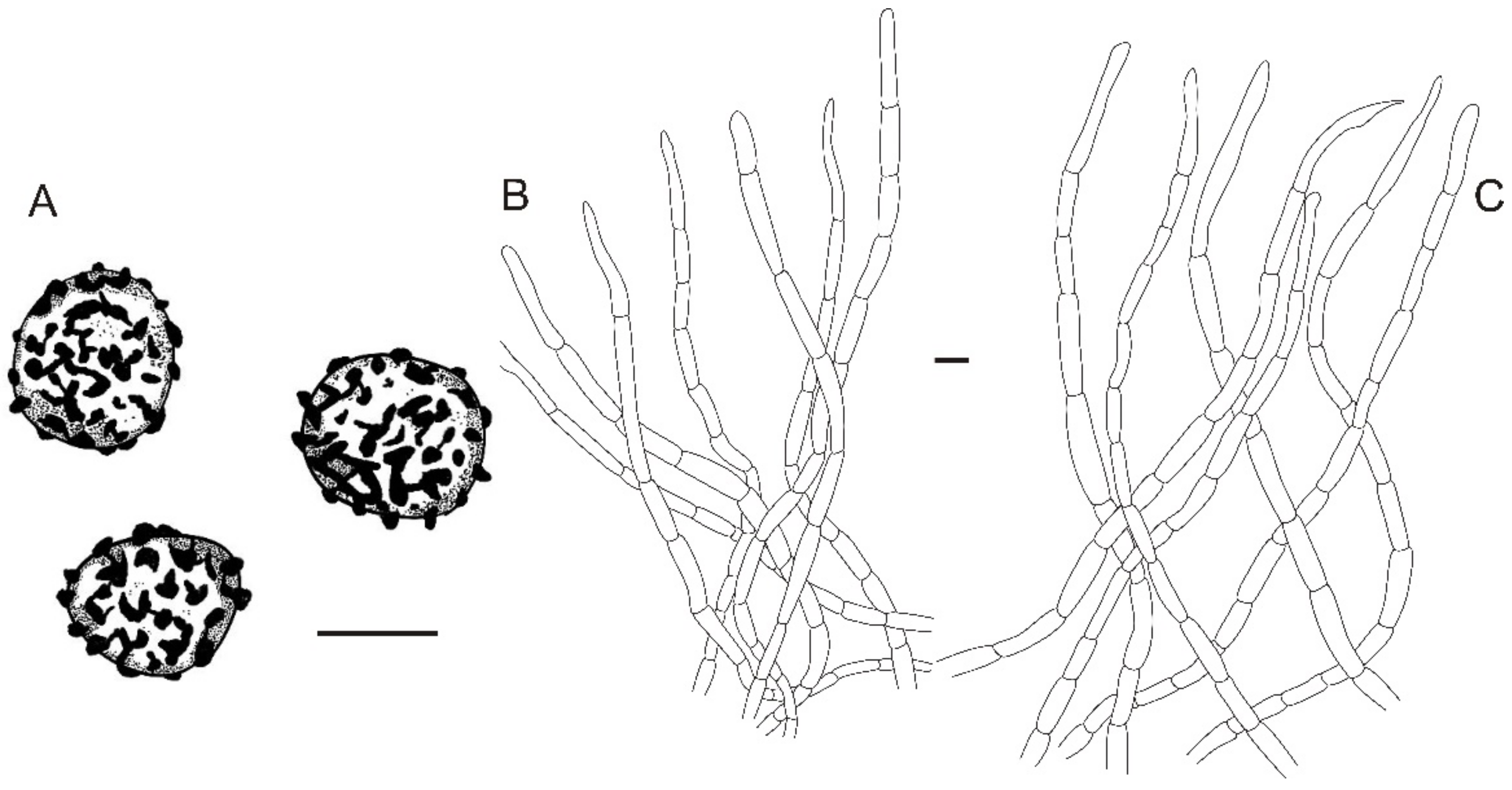
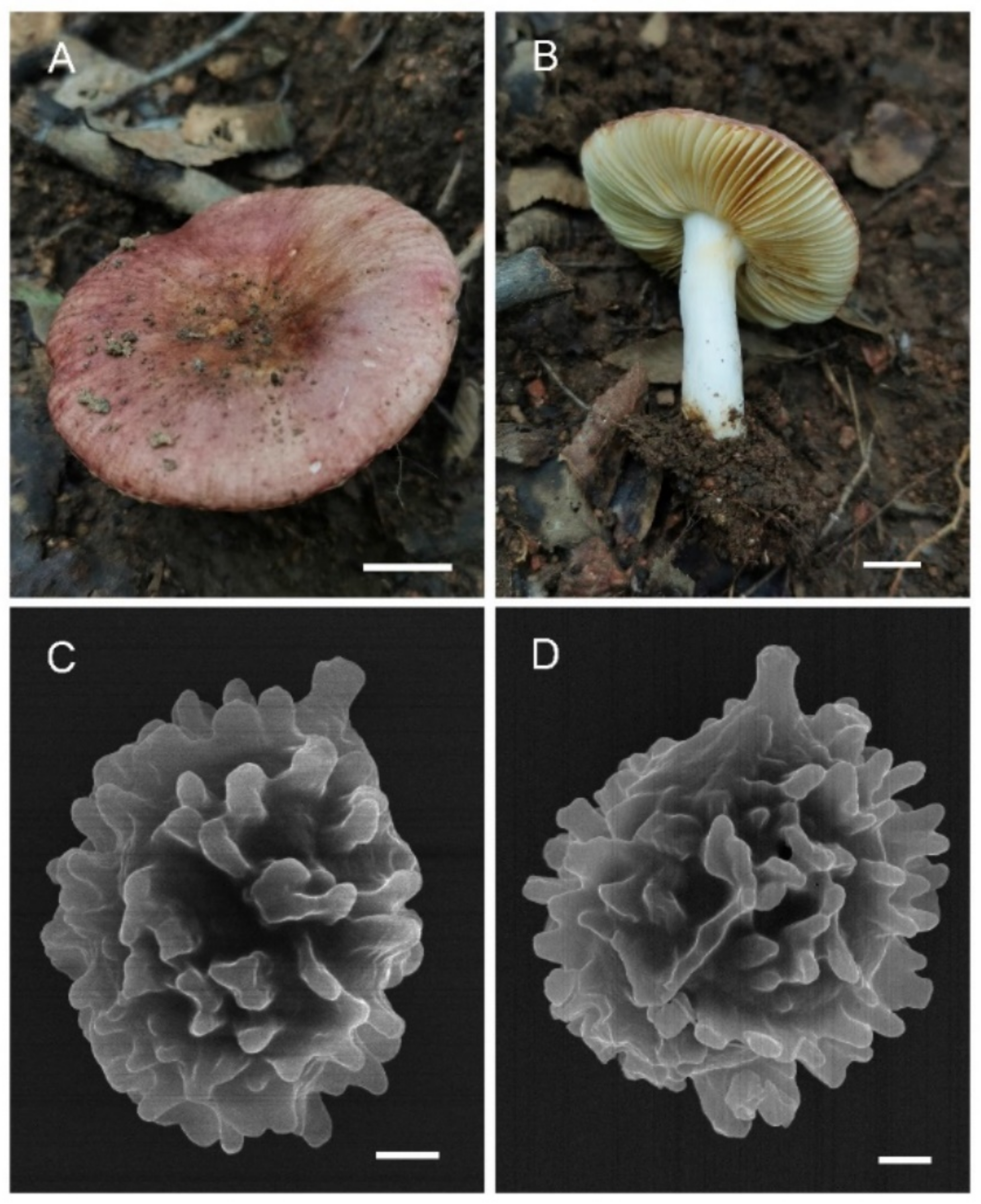



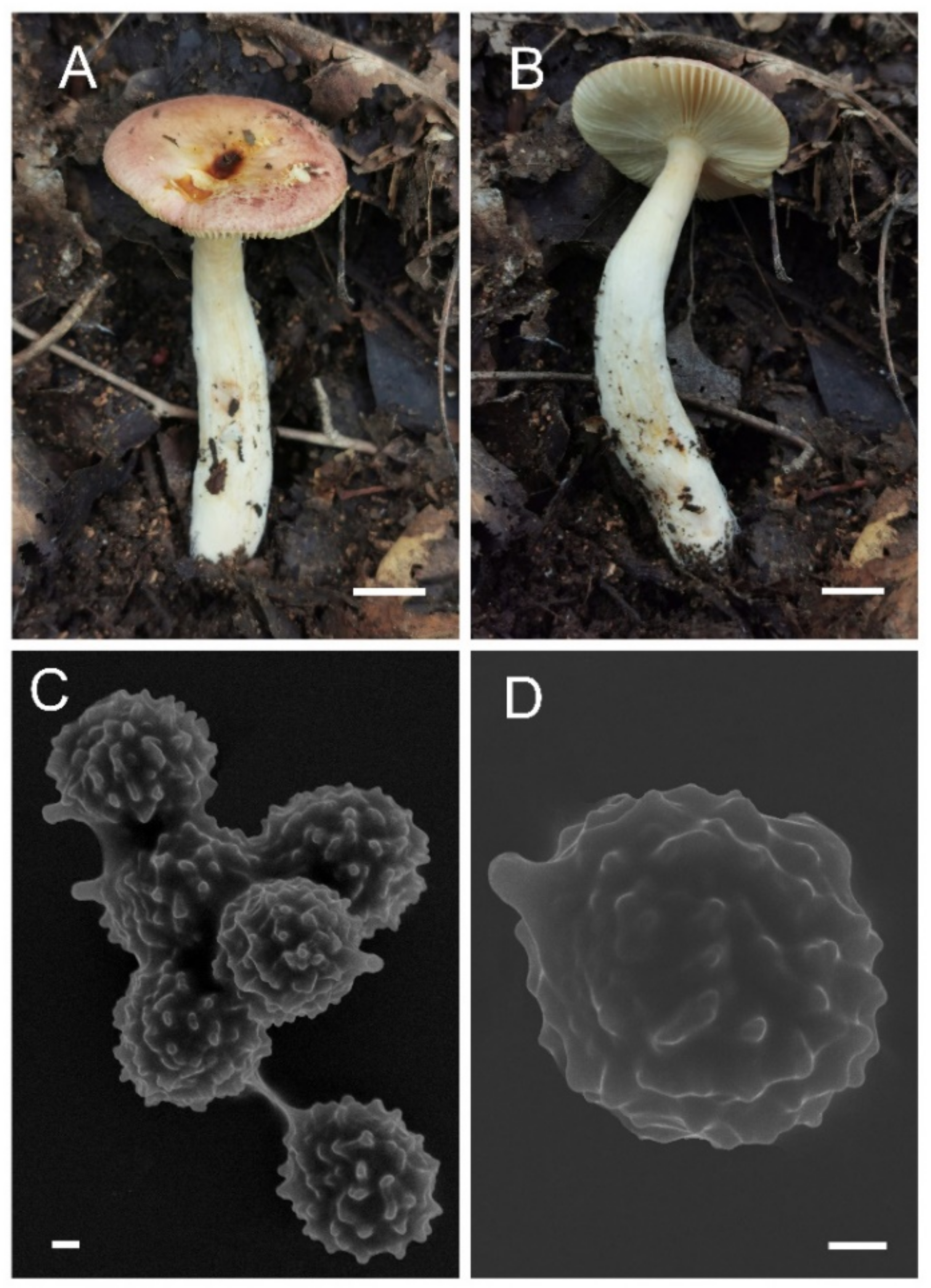
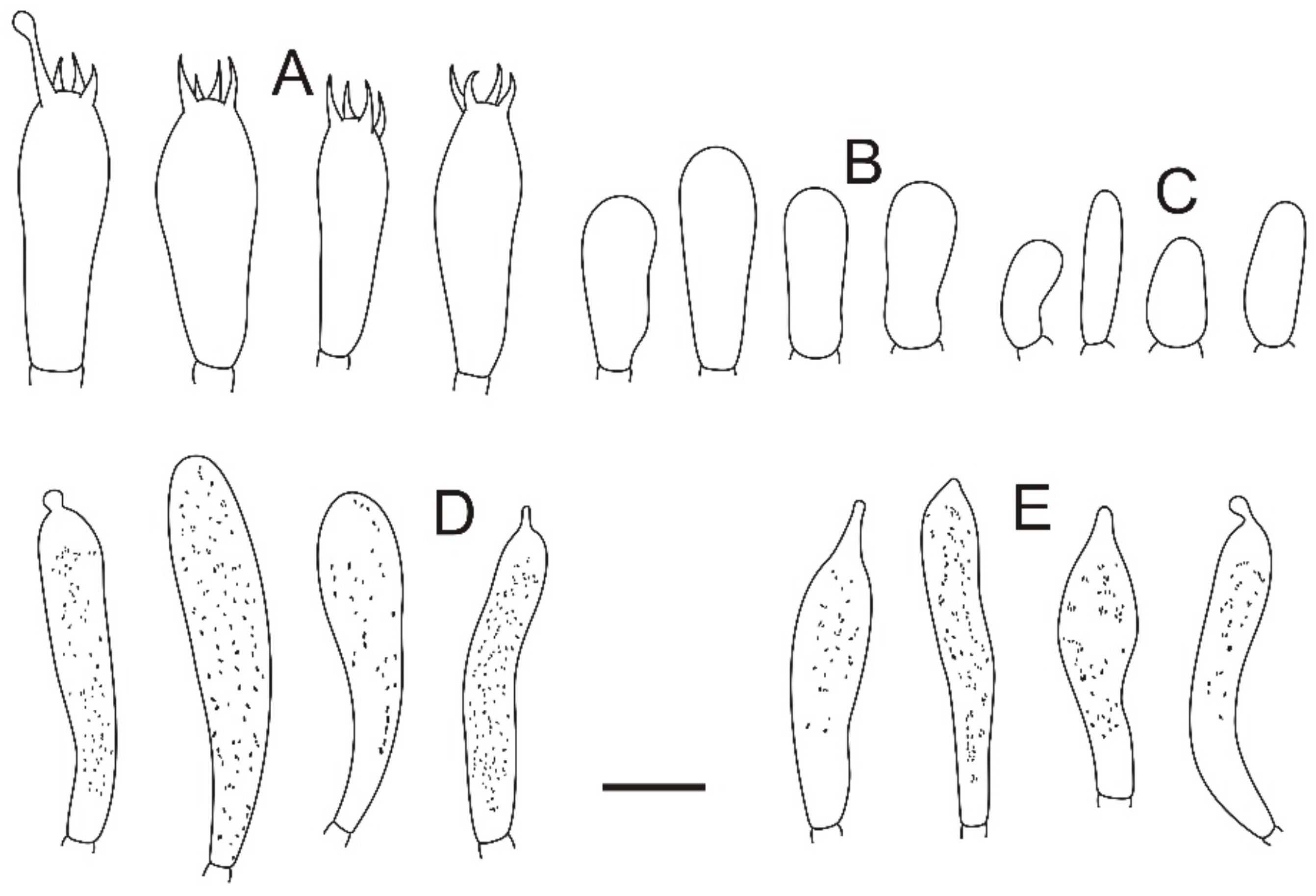
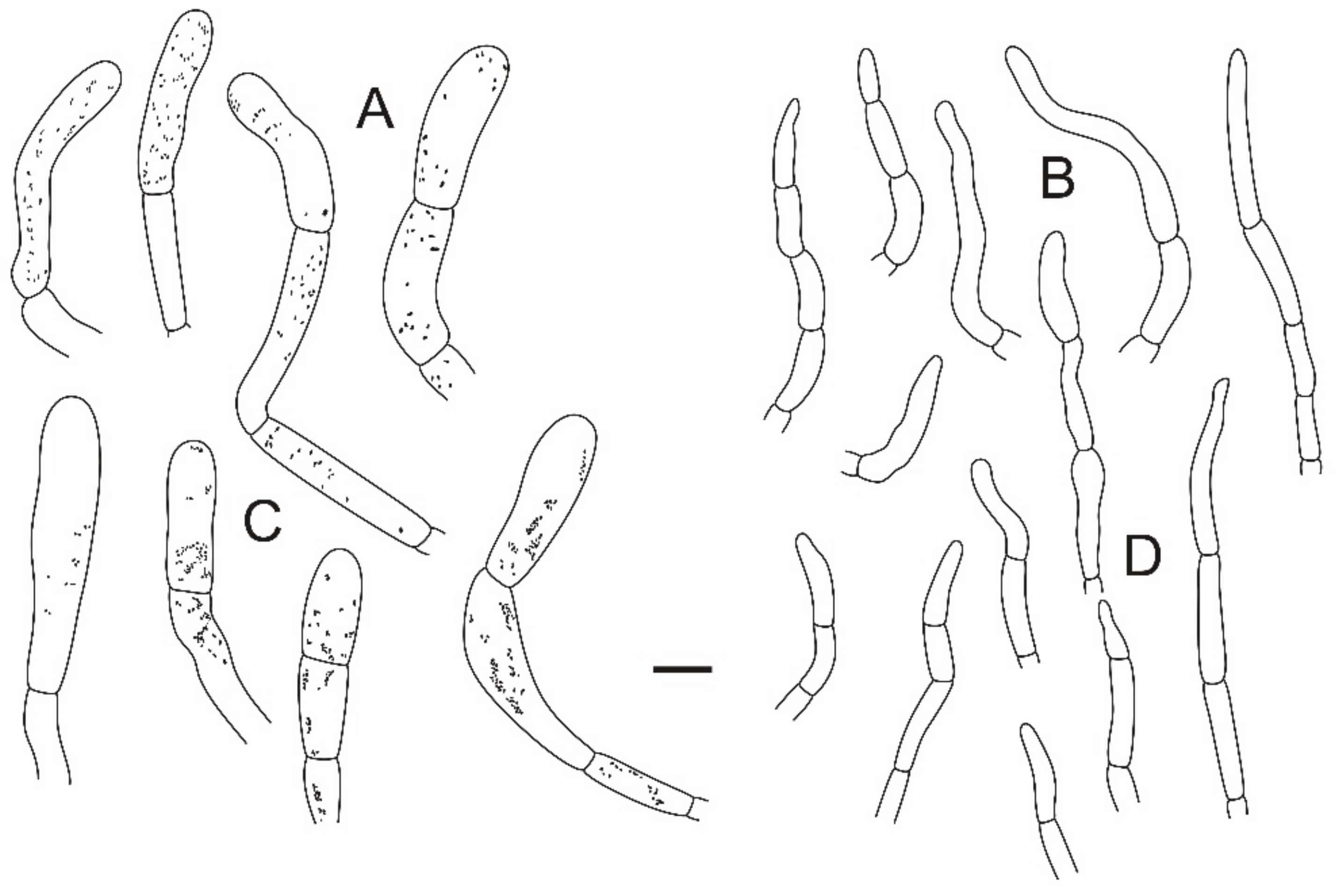

| Taxa | Voucher | Location | GenBank Accession Numbers | |||
|---|---|---|---|---|---|---|
| nrLSU | mtSSU | rpb2 | tef-1α | |||
| Multifurca aurantiophylla | 644/BB 09.119 | New Caledonia | KU237581 | KU237429 | KU237867 | KU238008 |
| Multifurca ochricompacta | 580/BB 07.010 | USA | KU237565 | KU237413 | KU237851 | KU237994 |
| Russula abbottabadensis | LAH 310071 | Pakistan | MN518356 | MG386719 | MG386737 | MZ364137 |
| Russula abbottabadensis | FH 00304558 | Pakistan | MN518355 | MG386721 | MG386738 | MZ364138 |
| Russula acrifolia | 543/BB 08.662 | Italy | KU237535 | KU237381 | KU237821 | KU237965 |
| Russula adusta | 223/BB 06.562 | Canada | KU237476 | KU237320 | KU237762 | KU237907 |
| Russula amethystina | 529/BB 07.314 | Slovakia | KU237521 | KU237367 | KU237807 | KU237951 |
| Russula archaeosuberis | 1118/BB 12.085 | Italy | KU237593 | KU237441 | KU237878 | KU238019 |
| Russula ayubiana | LAH 35438 | Pakistan | MZ358816 | MZ364121 | MZ364131 | MZ364139 |
| Russula ayubiana | LAH 35439 | Pakistan | MZ358817 | MZ364122 | MZ364132 | MZ364140 |
| Russula azurea | 537/BB 08.668 | Italy | KU237529 | KU237375 | KU237815 | KU237959 |
| Russula betularum | BPL269 | USA | KT933829 | KT933969 | KT933900 | - |
| Russula bicolor | HMJAU 32180 | China | KX095080 | KX095031 | - | - |
| Russula brevipes | 226/BB 06.508 | Mexico | KU237479 | KU237323 | KU237765 | - |
| Russula burlinghamiae | 548/BB 05.108 | USA | KU237540 | KU237386 | KU237826 | KU237970 |
| Russula carpini | 551/BB 07.262 | Slovakia | KU237543 | KU237389 | KU237829 | KU237973 |
| Russula chloroides | 572/BB 07.209 | Slovakia | KU237559 | KU237407 | KU237845 | KU237990 |
| Russula compacta | 228/BB 06.295 | USA | KU237480 | KU237324 | KU237766 | - |
| Russula corallina- | 229/BB 06.324 | USA | KU237481 | KU237325 | KU237767 | KU237910 |
| Russula crustosa | BPL265 | USA | KT933826 | - | KT933898 | - |
| Russula cuprea | 565/BB 07.233 | Slovakia | KU237555 | KU237401 | KU237841 | KU237984 |
| Russula decolorans | 549/BB 07.322 | Slovakia | KU237541 | KU237387 | KU237827 | KU237971 |
| Russula emetica | 635/JMT39-08092228 | France | KU237578 | KU237426 | KU237864 | - |
| Russula exalbicans | 584/BB 07.786 | France | KU237568 | KU237416 | KU237854 | KU237996 |
| Russula farinipes | 576/BB 08.632 | Italy | KU237561 | KU237409 | KU237847 | KU237992 |
| Russula fattoensis | Buyck 02.227 | USA | MN315514 | MN315537 | MN326797 | MN326800 |
| Russula fragilis | 443/BB 07.791 | France | KU237506 | KU237351 | KU237792 | - |
| Russula glutinosa | Roody WRWV 04.1154 | USA | MN315511 | MN315532 | MN326798 | MN326799 |
| Russula gracillima | 441/BB 07.785 | France | KU237504 | KU237349 | KU237790 | KU237934 |
| Russula griseobrunnea | JAC11227 | New Zealand | MW683630 | |||
| Russula herrerae | 239/BB 06.532 | Mexico | KU237486 | KU237330 | KU237772 | KU237915 |
| Russula integra | 518/BB 07.198 | Slovakia | KU237513 | KU237359 | KU237799 | KU237943 |
| Russula laeta | 519/BB 07.267 | Slovakia | KU237514 | KU237360 | KU237800 | KU237944 |
| Russula laricina | 575/BB 08.681 | Italy | KU237560 | KU237408 | KU237846 | KU237991 |
| Russula leucomarginata | RITF3133 | China | MW309327 | MW309338 | MW310568 | - |
| Russula leucomarginata | RITF3123 | China | MW309328 | MW309339 | MW310569 | - |
| Russula lilacea | 435/BB 07.213 | Slovakia | KU237498 | KU237343 | KU237784 | KU237928 |
| Russula mansehraensis | HUP SUR 180 | Pakistan | MG944280 | MG944266 | MG944255 | - |
| Russula mansehraensis | HUP SUR 803 | Pakistan | - | MG944267 | MG944256 | - |
| Russula minutula | 539/BB 08.636 | Italy | KU237531 | KU237377 | KU237817 | KU237961 |
| Russula miyunensis | BJTC Z1357 | China | - | OP135984 | OP156826 | OP156837 |
| Russula miyunensis | BJTC Z1355 | China | OP133232 | OP135985 | OP156827 | - |
| Russula mustelina | 1176/SA 09.88 | Slovakia | KU237596 | KU237444 | KU237881 | KU238022 |
| Russula nauseosa | 588/BB 07.285 | Italy | KU237572 | KU237420 | KU237858 | KU238000 |
| Russula nigricans | 429/BB 07.342 | Slovakia | KU237495 | KU237339 | KU237781 | KU237924 |
| Russula nothofagineae | 723/BB 09.044 | New Caledonia | KU237583 | KU237431 | - | KU238010 |
| Russula nothofagineae | 726/BB 09.069 | New Caledonia | KU237585 | KU237433 | KU237870 | KU238012 |
| Russula odorata | 526/BB 07.186 | Slovakia | KU237518 | KU237364 | KU237804 | KU237948 |
| Russula olivascens | 530/BB 08.663 | Italia | KU237522 | KU237368 | KU237808 | KU237952 |
| Russula olivobrunnea | JV28388 | Finland | - | MW633232 | - | - |
| Russula plana | BJTC Z1398 | China | OP133233 | OP135986 | OP156828 | OP156838 |
| Russula plana | BJTC T2101 | China | OP265903 | OP265901 | OP267556 | OP267558 |
| Russula pseudoaurantiophylla | 740/BB 09.219 | New Caledonia | KU237591 | KU237439 | KU237876 | KU238017 |
| Russula puellaris | 523/BB 07.311 | Slovakia | KU237515 | KU237361 | KU237801 | KU237945 |
| Russula purpureoverrucosa | GDGM32902 | China | MG214699 | - | MT085652 | MT085623 |
| Russula quercus-floribundae | LAH 36219 | Pakistan | MN513043 | MN053397 | MN053389 | MZ364152 |
| Russula quercus-floribundae | LAH 36220 | Pakistan | MN513043 | MN053396 | MN053390 | MZ364153 |
| Russula raoultii | 561/BB 08.674 | Italy | KU237551 | KU237397 | KU237837 | KU237980 |
| Russula rosea | 430/BB 07.780 | France | KU237496 | KU237340 | KU237782 | KU237925 |
| Russula roseola | RITF3418 | China | MW309319 | MW309330 | MW310560 | - |
| Russula roseola | RITF3428 | China | MW309320 | MW309331 | MW310561 | - |
| Russula sinoparva | BJTC C540 | China | OP133234 | OP135987 | OP156829 | OP156839 |
| Russula sinoparva | BJTC Z441 | China | OP133235 | OP135988 | - | OP156840 |
| Russula sinorobusta | BJTC Z050 | China | OP133236 | OP135989 | OP156830 | OP156841 |
| Russula sinorobusta | BJTC Z052 | China | - | OP135990 | - | OP156842 |
| Russula sinorobusta | BJTC Z662 | China | OP133237 | OP135991 | OP156831 | OP156843 |
| Russula sichuanensis | ZRL20162017 | China | MG786572 | MG792323 | - | MG812160 |
| Russula solaris | 559/BB 07.282 | Slovakia | KU237549 | KU237395 | KU237835 | KU237978 |
| Russula sp. | 735/BB 09.172 | New Caledonia | KU237588 | KU237436 | KU237873 | KU238015 |
| Russula subsanguinaria | RITF2236 | China | MW309322 | MW309333 | MW310563 | - |
| Russula subsanguinaria | RITF2208 | China | MW309323 | MW309334 | MW310564 | - |
| Russula subtilis | 536/BB 05.107 | USA | KU237528 | KU237374 | KU237814 | KU237958 |
| Russula subversatilis | BJTC C653 | China | OP133238 | OP135992 | OP156832 | OP156844 |
| Russula subversatilis | BJTC T2001 | China | OP265904 | OP265902 | OP267557 | OP267559 |
| Russula turci | 528/BB 07.328 | Slovakia | KU237520 | KU237366 | KU237806 | KU237950 |
| Russula versicolor | 589/BB 07.288 | Slovakia | KU237573 | KU237421 | KU237859 | KU238001 |
| Russula vinosobrunneola | HMAS 281138 | China | MG786569 | MG792320 | - | MG812157 |
| Russula vinosobrunneola | HMAS 278885 | China | MG786570 | MG792321 | - | MG812158 |
| Russula yanshanensis | BJTC C561 | China | OP133239 | OP135993 | - | OP156845 |
| Russula yanshanensis | BJTC Z1448 | China | OP133240 | OP135994 | OP156833 | - |
| Russula yanshanensis | BJTC Z421 | China | OP133241 | OP135995 | - | OP156846 |
| Russula yanshanensis | BJTC Z1385 | China | OP133242 | OP135996 | - | OP156847 |
| Russula yanshanensis | BJTC Z1305 | China | OP133243 | OP135997 | OP156834 | OP156848 |
| Russula yanshanensis | BJTC Z1390 | China | OP133244 | OP135998 | OP156835 | OP156849 |
| Russula yanshanensis | BJTC L349 | China | OP133245 | OP135999 | OP156836 | OP156850 |
| Russula zvarae | 538/BB 08.639 | Italy | KU237530 | KU237376 | KU237816 | KU237960 |
Publisher’s Note: MDPI stays neutral with regard to jurisdictional claims in published maps and institutional affiliations. |
© 2022 by the authors. Licensee MDPI, Basel, Switzerland. This article is an open access article distributed under the terms and conditions of the Creative Commons Attribution (CC BY) license (https://creativecommons.org/licenses/by/4.0/).
Share and Cite
Zhou, H.; Cheng, G.-Q.; Wang, Q.-T.; Guo, M.-J.; Zhuo, L.; Yan, H.-F.; Li, G.-J.; Hou, C.-L. Morphological Characteristics and Phylogeny Reveal Six New Species in Russula Subgenus Russula (Russulaceae, Russulales) from Yanshan Mountains, North China. J. Fungi 2022, 8, 1283. https://doi.org/10.3390/jof8121283
Zhou H, Cheng G-Q, Wang Q-T, Guo M-J, Zhuo L, Yan H-F, Li G-J, Hou C-L. Morphological Characteristics and Phylogeny Reveal Six New Species in Russula Subgenus Russula (Russulaceae, Russulales) from Yanshan Mountains, North China. Journal of Fungi. 2022; 8(12):1283. https://doi.org/10.3390/jof8121283
Chicago/Turabian StyleZhou, Hao, Gui-Qiang Cheng, Qiu-Tong Wang, Mei-Jun Guo, Lan Zhuo, Hui-Fang Yan, Guo-Jie Li, and Cheng-Lin Hou. 2022. "Morphological Characteristics and Phylogeny Reveal Six New Species in Russula Subgenus Russula (Russulaceae, Russulales) from Yanshan Mountains, North China" Journal of Fungi 8, no. 12: 1283. https://doi.org/10.3390/jof8121283
APA StyleZhou, H., Cheng, G.-Q., Wang, Q.-T., Guo, M.-J., Zhuo, L., Yan, H.-F., Li, G.-J., & Hou, C.-L. (2022). Morphological Characteristics and Phylogeny Reveal Six New Species in Russula Subgenus Russula (Russulaceae, Russulales) from Yanshan Mountains, North China. Journal of Fungi, 8(12), 1283. https://doi.org/10.3390/jof8121283







